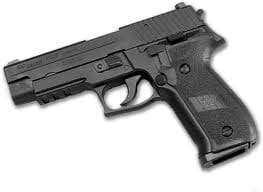I’m sure there are plenty of security guards that take their job seriously. They know what they’re doing. They train with their firearm and know how to use it safely to protect the people and property they’re hired to oversee. It’s pretty evident that Jack Kellogg wasn’t that kind of security guard . . .
Ian Cornett found that out the hard way when Kellogg accidently shot him in the leg back in February. Kellogg and Cornett were in an office building hallway when Kellogg dropped his gun and it fired. Now Cornett is suing both Kellogg and Sig Sauer. In addition to negligence on Kellogg’s part, the suit “claims the gun was defective in that it was able to discharge without anyone pulling the trigger.” Which no one who knows anything about guns will believe.
All of this, as you might expect, raises a few questions. The first and most important is why was Kellogg’s gun out of its holster? Lt. Steven Lewis of the Chesterfield, MO Police Department couldn’t answer that.
Lewis did confirm, though, that the gun was dropped but didn’t know the model of the Sig Kellogg was carrying. He did say “this isn’t a piece of crap gun” and “you can drop that gun on the hammer without it going off.” We do know it was a 9mm, so that would indicate that Kellogg was probably carrying a P226.
The P226 is a hammer-fired SA/DA pistol with a decocker. This isn’t a gun you carry in condition one like a 1911 because there’s no safety. Given the light trigger on the gun with the hammer back, carrying it cocked would be asking for an ND.
While confirming that the gun dropped Lt. Lewis said there were differing stories as to how the gun fired. Putting the pieces together with a healthy bit of educated speculation, here’s my guess as to what happened:
Kellogg had the gun out of his holster for reasons we probably won’t know unless and until the suit goes to trial. Is there something in the St. Louis water? Anyway, ol’ Jack was overcome by butterfingers.
What’s the natural reaction when you drop something? And what’s the worst thing you can do if the thing you drop is a gun? That’s right, you try to catch it. I’d lay odds that’s exactly what Kellogg did.
And he was almost surely carrying the gun with the hammer cocked. How do I know?Because with the hammer forward, the trigger has a very long DA pull like a revolver. It’s almost impossible – even if Kellogg tried to catch it – to cause the gun to fire accidentally. With the hammer cocked, the pressure needed to fire it is negligible.
If the gun had simply fallen and hit the ground, even with the hammer back, there’s almost zero chance it would have fired. Something I’m sure Sig will be demonstrating for the jury. If it gets that far. Which it probably won’t.
But all of this goes back to the original question: why the hell did Kellogg have the gun out of his holster? The more a gun is handled, the higher the chances of an ND. So never try to catch a dropped gun. But feel free to pick it up—carefully—afterwards.






the suit “claims the gun was defective in that it was able to discharge without anyone pulling the trigger.”
Annoying that this guy is suing Sig but it’s pretty easy to disprove, just try to replicate it. Unless this moron compounded his stupidity by modifying the gun, in which case it is still not Sig’s fault, the gun will not go off without pulling the trigger.
Yeah but then they’d have to go to court and most big companies just settle. Not sure if that applies in this industry though, as a settlement on something like that could be more costly to the brand.
Probably a Sig P226 or P229. The trigger pull on DA is 10 pounds; on SA it’s 4.5 pounds. My guess is he had the hammer cocked, dropped the gun, and grabbing it, naturally gripped his hand to catch it with his finger on the trigger, firing the cartridge in the chamber.
Speculation is a dangerous thing … Me too:
The dude (Kellogg) was showing off his ammo selection. He pulled the magazine out and cleared the gun, showed off his super-cool expanding ammo, and–as he was reloading it–dropped the pistol. He had just chambered a round, so the hammer was cocked. While shifting his grip to reach the decocker with his stubby digit, the gun slipped out Kellogg’s limp-wristed grip and fell. As it fell, the trigger caught his finger, or his finger caught it … Or, by some miracle, it caught something else on the way down. A fully-loaded P226 or P229 is plenty heavy enough to pull through the light SA trigger should it catch on something.
There’s a decent chance that the pistol never actually hit the ground–it may have simply slipped in the hand (again, between chambering and decocking) or Kellogg simply had no trigger discipline during the reloading procedure. The story might have been falsified by the plaintiff, Cornett, to reduce the penalty to his buddy, Kellogg. If the gun was defective, his buddy doesn’t have to lose his job and insurance will cover his liabilities.
We’ll probably never know. Meh.
True. It’s all speculation at this point, peppered with some knowledge of how Sigs work and when you’re not supposed to have your gun out of its holster.
Oh, and Cornett wasn’t a buddy (to my knowlege). Just someone who worked in the building. But who knows? Maybe they were mall ninjas fondling Kellogg’s cool new piece.
Granted, the P220/P226/P229 is carried with a round in the chamber and the hammer de-cocked. But the gun going off in that state when dropped is highly unlikely. Or practically impossible, whichever you prefer.
These guns have both a hammer block and a firing pin block. When you de-cock the gun, the hammer comes to rest approximately an eighth of an inch away from the end of the firing pin. But it will not touch that pin. For a ND to occur, you would have to pull the trigger first. It’s the only way the hammer will be free to move far enough forward to strike the firing pin.
Also, that is why you can de-cock the thing all day and all night and never have to worry about the gun accidentally firing; It can’t.
So, like everyone before me has said, who the hell knows what this knucklehead was doing to cause his SIG to go bang. But I’ll bet he was doing something he shouldn’t have been.
On the older SIGs, (sharp hammer) if you lower the hammer with your thumb rather than use the De Cocker, it rides on the firing pin with no impediment. Obviously, this is because you pulled the trigger. Newer SIGs have a rebounding hammer that brings itself to a half cocked position.
About 50 years ago, my dad (a LEO) had a ND at home while he was putting on his officers uniform. (That’s why his S&W duty revolver was out of its holster lying on the bed at the time).
Somehow, the gun slipped off the bed. He grabbed for it, and BANG!
Dad had about 10 yrs on the job at that point, so I can’t believe he purposely cocked the hammer into the lighter trigger pull of the SA mode of the revolver.
Rather, I suspect, he panicked while grabbing for the falling gun. Before it hit the floor he most likely squeezed that 10+ lb DA trigger, by accident, causing the (Negligent) discharge.
Luckily, the muzzle happened to be pointing in a safe direction. The 38 Sp round went straight through the mattress, out through the outside BRICK wall of our house and lodged into the brick of the neighbor’s house next door.
Comments are closed.